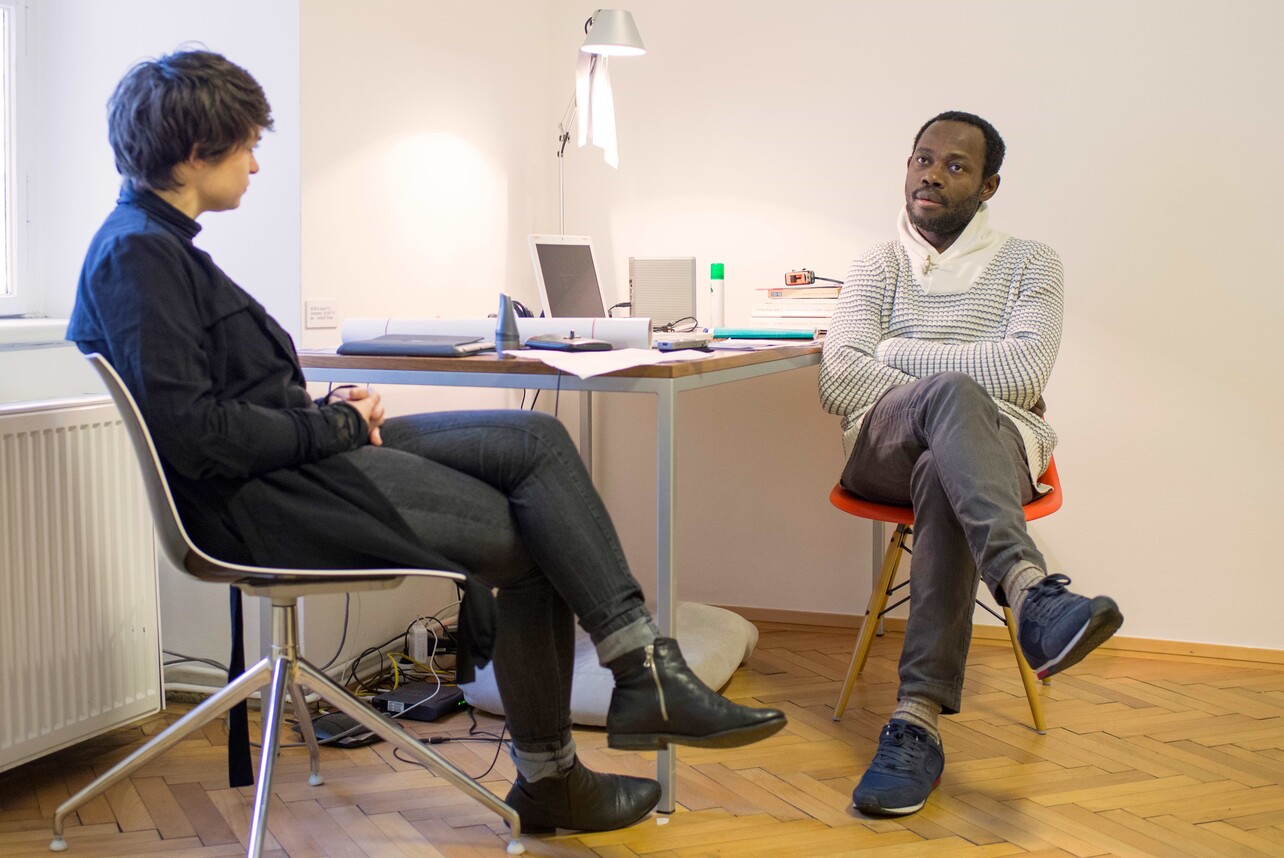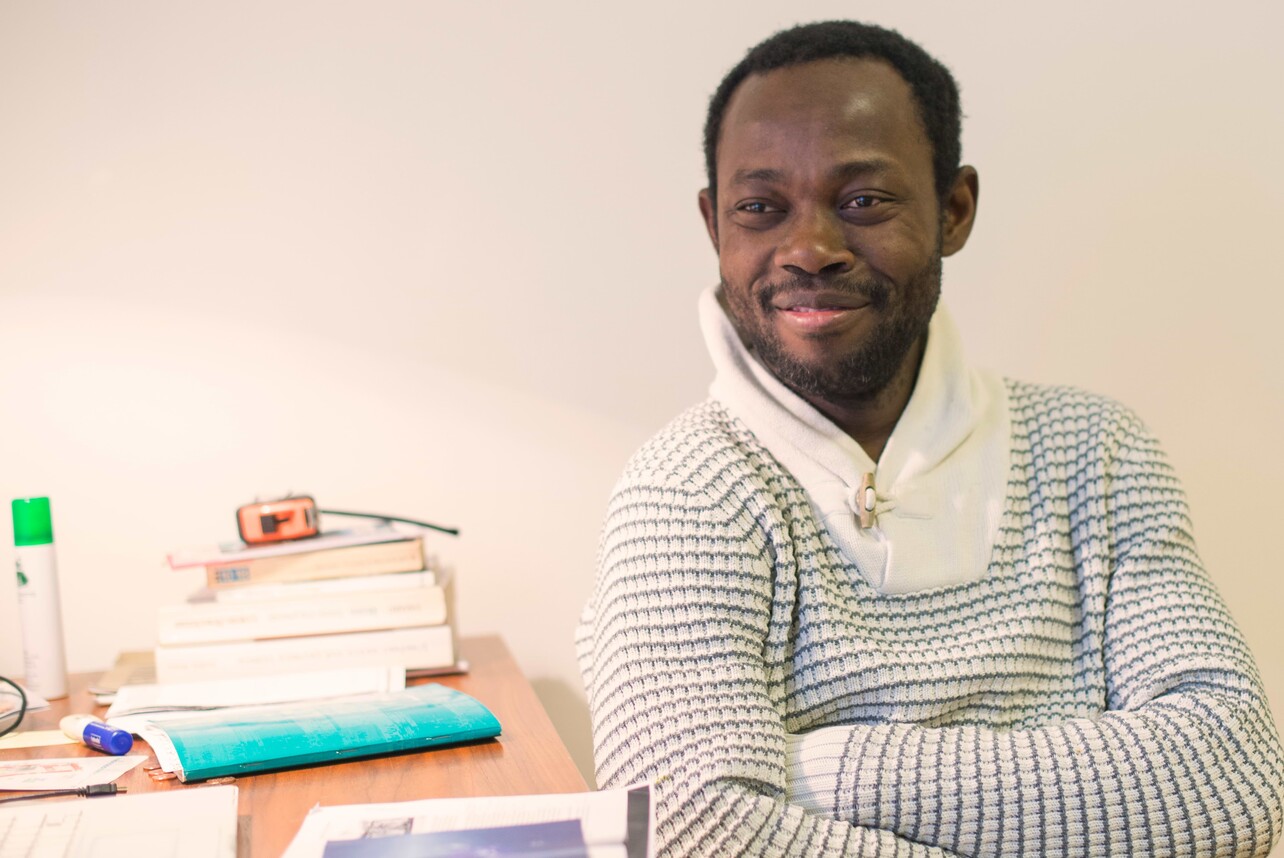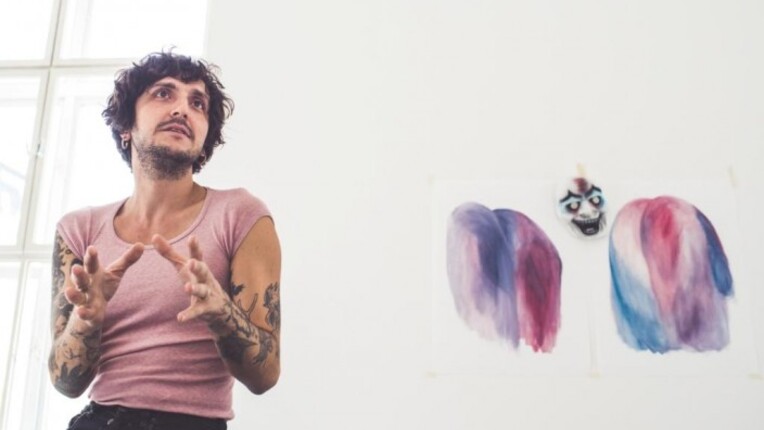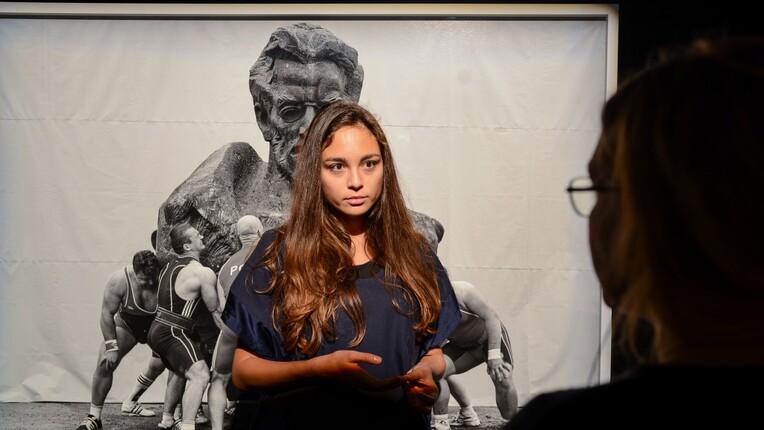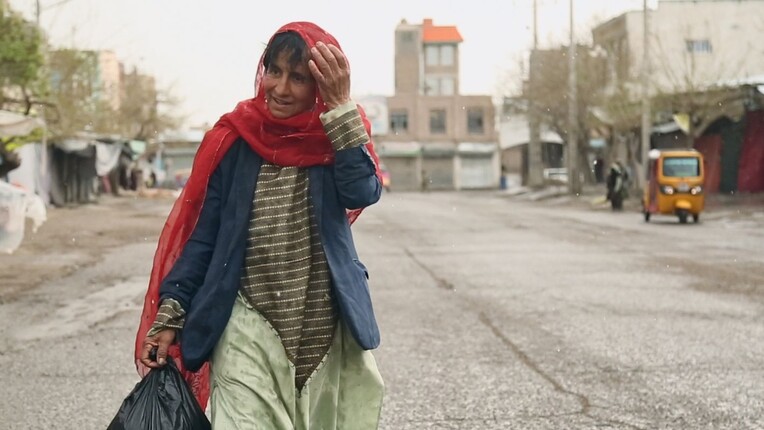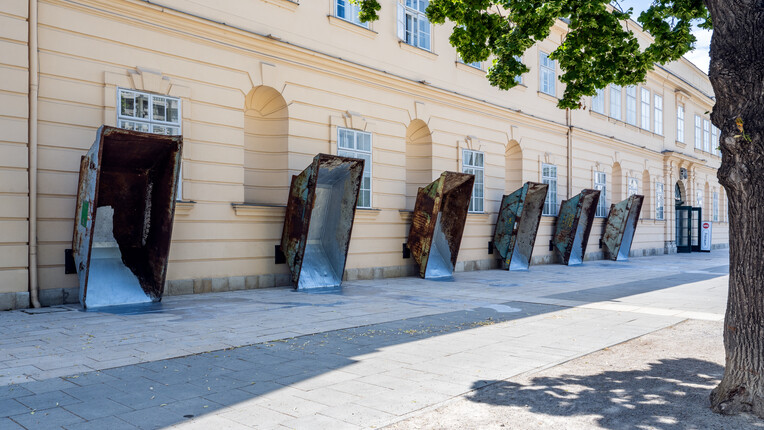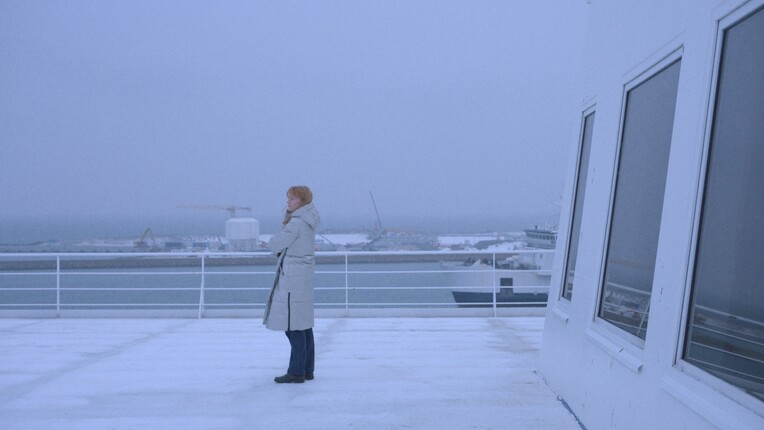
"In my language there is no word for art."
Interview with Artist-in-Residence Guy Wouete
My first question is kind of a meta question: How would you define art?
Guy: Art! I mean, in my language (Bandrefan) there is no word for “art”. But there are a lot of words you can use for “sculpture”, “painting”, “photography” or “picture”. Actually we don’t say “photography” in my language, we say “picture”. So I have to say that in my language there isn't any generic word such as “art”. From my perspective, there is not a specific thing that corresponds to the word “art”. The idea in my language is to try to mention certain things which are different and which function on a symbolic, spiritual and aesthetical level. Art is just something which is different within life. It is not outside of life, but part of life. That’s how I can define art.
That’s an interesting definition. Does that also mean that it is difficult for you to discuss art and what art is or can be in other languages?
No. I don’t mean that it is difficult to discuss art. But I find it a bit problematic to define art. We can discuss art. But when we start to define art, it can get a bit complicated. Because everyone experiences art differently and therefore there are a lot of definitions of art, of what we call art. We can discuss art as long as we don’t define it, as long as we don’t confine it.
I understand. So let’s be a bit more subjective. What is art to you?
What is art to me? Oh…hm. It is difficult to express what art is to me. And it gets even more complicated when I start to think about what is not art… I mean, art from my own perspective is actually something that makes humans move somehow. Art is also a way of looking at life. I think we could also talk about art from a technical perspective and it will become something different. Then we start to speak as technicians. But in general I don’t see myself as a specialist in anything. Firstly, I see myself as a human being who is somehow living with art, with a certain philosophy of art, or let’s say being an artist. So that’s a bit what art is to me.
So what does it mean to you, being an artist, in the perspectives you mentioned?
Being an artist is being able to address an issue (issues of our society) without being in the position of a politician, who always targets benefits in their actions. Being an artist is also being able to confront people with their own realities in order to create spaces for encounter, for exchange and for alertness. It is also being able to find a certain beauty even when a situation is falling apart. Being an artist is being able to develop “beauty” through experiments, which can give hope to people far beyond the frontiers of our differences. Somehow, that's being an artist for me.
Being an artist is not really about producing an object (so-called art work) in the first place. No, for me being an artist is something different, it is a philosophy of life. It is trying to bring or to contribute something from your own point of view, going from your darkest fears to your highest aspirations and inner light.
So you repeatedly mentioned certain perspectives, let us stay there. You work in the fields of video, photography and painting. All these media deal with perspectives and points of view in a special visual way. Could you give us a more concrete example of how you use them in your work?
I actually think that sometimes it starts with life experiences, emotions or encounters that happened to me. The way someone smiles to me or not, or how someone is suspicious of me or how I feel in certain situations on the street or at home or somewhere else. That is kind of a starting point for me. I have to feel something; I have to be touched by an idea or an object. That is how I start to create, that is where the process starts. After being touched by something I decide which medium I want to use – whether it will be a photograph or an installation, a sculpture or a painting. Getting from the emotions or sensations I feel to producing a piece of art is a process in which many things happen. So, for example, I can be very fascinated by a movie and consequently decide to do research on an idea related to it. If they talk about the question of homeless people in the movie, it could be that I start research on the homeless situation in a country or a city. With the photography I produce in the research process, for example, I can present a work as an installation and build objects as well. So that it is my working process.
That’s interesting. You said that daily life is a source of your inspiration?
Yes, encounters in daily life.
Would you call yourself an observer of daily life?
I would say that I am more trying to be one, yes. But that is a really complex thing. I would love to say I am an observer. But there are many things I am not able to see, because I don’t have all the tools to oversee the composition of the whole situation. So it is difficult to be an observer. Still it is what I try do to. I try to be an observer of my time.
That was my question. I think, and that’s what I tried to ask you, as an observer you need a special mindset.
Yes! It is very important and kind of a life-long process. Learning to see, learning to really observe and being awake. Observing is a process of being awake, which is important for my art and my process as a human being. Because I consider myself a human being first – before being anything else, being a parent or an artist. All my work and most of my research focus on the challenge of staying awake. I am also trying to attract people's attention to the fact that we are not alone on earth. We are always with things, with spirits, with nature, with other people and a lot of emotions surrounding us. We really have to be aware of that. We have to care about that. Not because we want to change the whole world, that would be quite too idealistic, but it makes life better for each of us. So the question of awareness and being awake is quite important for me. That is what you mean about being an observer, I suppose. Being an observer means being awake. Keeping an open mind in order to see what is going on. I mean the good things as well as the bad things, trying to stay open-minded and being awake in every situation happening around you. This is the best way to say you are an artist. I think in that perspective Joseph Beuys was right when he said that everyone can be an artist.
Can I ask you about your practice? How do keep yourself open-minded?
That’s a good question. My practice is very simple. I only try as much as I can to offer or to share what I have. Like spiritual feelings, knowledge - technical knowledge as well as emotions. It is also the idea of letting people know that you're there and that they can count on you. And if they need you, you might be of help. This is my way of keeping myself awake and being aware in order to acknowledge people's value. Not trying to look at people as if they didn’t exist. It doesn’t mean being with people and thinking about them like I think about my bank account. I really try to be with you. I really try to pay attention to what you are saying and what you are doing and to the questions you ask. For me, this is kind of a life meditation process. I try, which doesn’t mean that I succeed. But at least I want to be that way.
Often your subject is immigration in the age of globalization and your works often convey or contain social criticism. How does this depend on your process of keeping yourself aware? And do these subjects always change?
They always change. I think that I cannot define my art or my production in the perspective of one idea or one subject. It always moves. I mean, I work on the question of immigration, but I also work on the question of health and I have also been busy with the question of in-between spaces and I did a lot of work on the question of love... it really varies a lot. Now I have been doing a video on the question of relationships, especially love relationships. Focusing on the question of how the simple fact that someone is linked to another person can influence both people in a love relationship, and how this fact impacts our lives. This is a really interesting topic for me at the moment, and since I’m dealing with intimate matters I find it quite challenging as well.
What is your production process? How do you do your research? By photography, by painting or reading, and afterwards translating it into another medium?
You mean especially for this topic?
For example, yes.
For this topic, as I already said, it always starts with personal feelings and questions about the idea of being linked to someone else. In term of media, at the moment, it goes from photography to video. I also did quite a lot of reading in order to understand myself. How do I function? Am I someone who is rather attached to people or to things? Am I an unstable person? This knowledge of yourself or this process of discovering other aspects of yourself brings something to the understanding of relationships.
Will we see parts of your current work at the upcoming exhibition “united nations extended – The Vienna Dialog”?
No, not at the moment. Before I came here I decided to go back to another topic on which I’ve been working. It is called Guy Wouete's Lamps. Lamps in terms of awareness or let’s say in the metaphoric sense. You need lamps, no matter where you are and where you want to go. To find your way, you need a lamp, Whether in a relationship, whether in your family or in your professional life.
Some of those works will be shown here in the exhibition that opens in March. Actually, I’ve been questioning certain aspects concerning the symbolic power and domination of societies through time and how they become visible in places. What can be a symbol of domination of a society? If we take the Austrian society for example: What are its symbols of domination, of greatness and power? Those are some of the things I’ve been looking at as types of lamps which make you aware of the relation system between countries, societies and political power.
Which symbols did you find?
That’s quite fascinating because here, for example, I’ve seen that the city of Vienna is really kind of a monumental thing, a very heavy environment full of huge buildings, most of them historical and very old. It is interesting to see how Austria cares for and values these old buildings and monuments. It is the country's representation and also a symbol of its “power, glory and domination” directed at societies or cities that don’t have these monuments or will never have them. It also has symbols that say “We are the greatest and the strongest”. I also try to look at a country like France and its capital Paris, one of the symbols of domination which actually has a link to culture. And that’s where we find a symbol of the power of art and culture as well: the Eiffel Tower. If a country or a society wants to present its power, it does so through art and culture or science. You can also see it in many paintings from the 15th century, by artists like Velázquez, representing kings, like the Spanish king (Philippe VI, 1653-55) and the battle scenes (The surrender of Breda, 1634-5), which were symbols of the power of the Spanish society at that time and still are today. In Paris, you have the Eiffel Tower (1889) which is really something unique (constructed five years after the Berlin Conference, 1884) that was conceived as the entrance arch to the 1889 World's Fair where black people where exhibited as animals in a zoo. In New York you have the Statue of Liberty... These are not just cultural symbols but also symbols of power and domination. With messages like “we made it” and “we are the people who hold the power”. I’ve been working with such symbols. Some of those works will be visible in the exhibition “united nation extended – The Vienna Dialog”.
I am looking forward to your works. At last I have some questions concerning your biography as well as your personal experiences. Grown up, living and working in Cameroon, West Africa, you studied art in Europe. Now you move between the two continents as a kind of nomadic artist. What experiences did you make whilst traveling between the continents and how does this influence your artwork or, let’s say, you as a human being?
Actually I think, and this is not really for me to say because most people know that as well, to be a "human being" does not mean to be sedentary. A human being is not a tree. Usually you don’t grow up and die in the same place. Since antiquity people have always been in a process of moving, first because of natural needs (looking for food and better places according to seasons) and then because of force (natural catastrophes, conquest, slavery...). For me it is just something which has become normal today, to be from here and there at the same time. And it has also become normal to let my mind be influenced by things which are happening in the North, South, West and East. It is an interesting way of living and being as well, because I’ve been meeting a lot of people and seeing a lot of things, having quite some experience, both good and bad, which taught me somehow to understand what life is. It is not something that you can just look at from a black-and-white perspective. There are a lot of nuances and there are also things that are very difficult to change. When you travel you can also discover that, no matter how open-minded people are, once they feel insecure they directly fall back to their tiny little so-called roots. And they can be xenophobic, they can be racist, yes, they can be extremist and fanatic. They can treat you as a non-being. So those are some little things that you can learn from moving into different spaces. You learn to know and to accept how and who you are. You understand that you should always be careful, because as soon as you forget, people will remind you of who you are. So you should define who you are for yourself before you make contact with others most of the time. If not, they are going to decide who you are for you and tell you where you should be. These are all things that you learn moving from one place to another. We could talk about this the whole day, but I think this will be enough for the moment.
Interview: Hannah Schwegler
Photos: Eva Ellersdorfer-Meissnerová
“united nations extended – The Vienna Dialog”
#UNE #TheViennaDialog
